August 7, 2019 -- First Pickles of the Season
Someone ate my first planting of cucumber seeds this spring (and the
squash, too!) so I replanted later than I normally plant. Being
concerned that the crop would be limited because of that I planted
extras. Turns out that wasn't at all necessary and I now have a crowded,
thriving, green jungle of cucumber plants in my plot, happily putting
out cucs right and left and right on schedule. They know when it's time
to produce. Plants probably get quite a chuckle at human's fussing and
calendar watching.
They did catch me a bit by surprise, since I thought they'd be later,
but when I noticed some full sized cucumbers I was quite happy to grab a
basket and pick enough for the first batch of fermented pickles. I do both fermented and vinegar pickles; not so many of the
first and more of the second since they last longer. The ferments are for "fresh" eating while the vinegared are mostly
cut up in salads and dishes.
Since ferments are alive and ever changing their shelf life is limited.
How long they are good depends a lot on the temperature and the
season and weather. The first batch of the season is barely given time
to get going before being eaten since it's been a good
long while since we've had any. In a week or two we'll start sampling
this first batch.
They won't last long. But they are very easy to make so more will be on
their way soon. I spread out my pickling - a small batch of
ferments now, then several batches of vinegar, which aren't hard
to make but they take a bit more time so it depends on my schedule and
how the cucs are ripening. This year I think I'll be giving cucumbers
away!
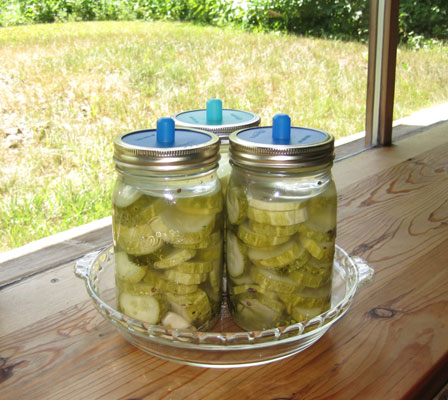 But
not until the pickle shelf is full. If you've never had fresh
fermented pickles you might want to give them a try. We like them. I'd made
them off and on through the years, using directions from here and there,
coming up with my own recipe.
Usually they turned out good, though it's not a sure thing. But a few years
ago I bought a book that got me enthused once again about ferments -
"Fermented Vegetables" by Kirsten and Christopher Shockey. Now most of
their well written and wonderfully photographed book is a bit lost on me, being quite fond of simplicity in my
own kitchen/preserving life and not
much inclined to add to it. But I enjoyed reading the book
anyway and was really amazed at the array of ferments. They do a
great job of explaining the ins and outs and particulars of fermenting -
well worth it even if you don't want to ferment everything in sight. I
did try a few new things and came up with an adaptation of their onion
and sweet pepper relish that I really liked. I'll do that one again when
my peppers are ripe. It's a fun book.
But
not until the pickle shelf is full. If you've never had fresh
fermented pickles you might want to give them a try. We like them. I'd made
them off and on through the years, using directions from here and there,
coming up with my own recipe.
Usually they turned out good, though it's not a sure thing. But a few years
ago I bought a book that got me enthused once again about ferments -
"Fermented Vegetables" by Kirsten and Christopher Shockey. Now most of
their well written and wonderfully photographed book is a bit lost on me, being quite fond of simplicity in my
own kitchen/preserving life and not
much inclined to add to it. But I enjoyed reading the book
anyway and was really amazed at the array of ferments. They do a
great job of explaining the ins and outs and particulars of fermenting -
well worth it even if you don't want to ferment everything in sight. I
did try a few new things and came up with an adaptation of their onion
and sweet pepper relish that I really liked. I'll do that one again when
my peppers are ripe. It's a fun book.
Ferments are pretty basic and simple. My recipe is basic and
simple. The tools required are simple, too. I made many a pickle,
and sauerkraut, in a crock with a plate and a rock or jar
of water for a weight. It works, and I still do that sometimes. But skimming off
the scum is a bit fussy. I found that for pickles doing them directly in
a jar works better - no or little skum to skim. But last year I discovered something
even easier - Pickle Pipes
made by MasonTops, along with their PicklePebbles glass weights. I
started with a set of
four, and it wasn't long before I ordered another set. I made do with those
8 last year, using a crock until a PicklePipe and Pebble was free then
transferring to a jar. I'm
not much for gizmos, especially in my kitchen, but I have to say these
things are not only cute they simply make ferments easy, more
reliable and trouble free.
So this is how I (usually) do it now:
Scrub and slice medium sized pickling cucumbers (large ones tend to get
mushy). Pack firmly into into a wide mouth quart jar along with these
optional options:
2 cloves garlic
fresh green
dill flowers/seeds (whatever stage is available)
grape leaf or horseradish root piece
1 tsp mixed pickling spice
Leave about 2" headroom if using Pipe & Pebble (less if not). Weight with
a PicklePebble.
Cover with brine made of 1 1/2 TB plain salt to quart of water
Put on a PicklePipe with metal ring
Leave for 3-5 days in kitchen (or somewhere around 70 deg) to begin
ferment, then move to cooler space, for me this is
the root cellar at about 60 deg this time of year. Start testing in about a week or two. Start eating when
you like the flavor. Move to a pint jar when half eaten. The ferment
brine is good, too, and good for you. It adds a real nice flavor to
bread or baked goods, or general cooking that needs liquid.
The last fermented pickles made end of season in September have kept
fairly well until March but they do tend to get soft by then, and that's
the end of the fermented pickles until the next season. These later
pickles get cooler storage temps as the root cellar
starts cooling down in October and is down to 40 degrees in November.
But that's a long ways off. Meantime, we look forward to the first fresh
fermented pickles in a week or two.
Cucumbers are good eaten fresh, too, of course, but mine prefer to be pickled.
So the cucumber I grow is the pickling sort. I’ve trialed many open-pollinated
varieties and so far Northern Pickling is the choice for my garden. Cucumbers
love warmth and space but there are varieties that can suit a wide range of
environments, from bush sorts for the small plot or those that can be trained up
a trellis, ones that are more adaptable to the hot and dry or varieties that
handle the cooler climes with finesse. The best way to choose the variety (or
varieties) for your garden is to experiment with many different ones, then grow
what does best for you.
If your garden is healthy and the soil reasonably rich in humus, you will
probably grow great healthy cucumbers. But even when I was still building up my
depleted sandy-loam soil I was able to get a small but usable cucumber crop.
They make do with what they have, just as people do, but do best in an
environment that suits them (as do people!). Since we have a fairly short
growing season here in the upper Midwest my goal is to get the plants growing
strong as early as possible to get a good crop before the frosts and freezes
arrive in the fall. Cucumbers are not fond of frost.
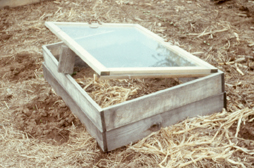 PLANTING
- Warmer climate gardeners plant their seed directly in the garden, grow and
harvest cucumbers as they mature and don’t worry much about a freeze prematurely
ending their harvest. But those of us with shorter seasons need to take a bit
more care if we want enough fruit for pickling. You can start your cucumbers
inside in small pots, transplanting them out later when the soil warms and
weather settles, and I have done that successfully. But my small greenhouse
space is at a premium in the spring and the less fussing I have to do with any
crop the happier I am. And a happier gardener makes for happier plants! So I use
cold frames.
PLANTING
- Warmer climate gardeners plant their seed directly in the garden, grow and
harvest cucumbers as they mature and don’t worry much about a freeze prematurely
ending their harvest. But those of us with shorter seasons need to take a bit
more care if we want enough fruit for pickling. You can start your cucumbers
inside in small pots, transplanting them out later when the soil warms and
weather settles, and I have done that successfully. But my small greenhouse
space is at a premium in the spring and the less fussing I have to do with any
crop the happier I am. And a happier gardener makes for happier plants! So I use
cold frames.
When the snow is gone from the garden, the dandelions are showing their cheery
blossoms, the apple tree’s buds are swelling and the daffodils are in full
bloom, it feels great to be out in the garden soaking up the sun, moving mulch
and digging in the dirt. Many seeds have already found their way into their
respective plots -- early greens, peas, carrot. Now it is time to set out
portable cold frames for the squash and cucumbers -- usually about mid-May here.
The cold frames suit me and the cucumbers. I can put them where I want them with
little fuss, and the plants can settle in without worrying about having to move
later.
As I have permanent, mulched, four foot wide beds, my preparation means moving
mulch instead of digging or tilling the soil. I rake the mulch off a bed where
the cucumbers will reside so the soil can warm. The cold frame boxes are set out
at a spacing of about three frames in 24 feet. A shovel of compost is dug into
the top inches of soil within the frame and several seeds are planted in each
quarter of the box. I cover them gently with dirt and, with a loving pat, leave
them to do what they most want to do -- grow. When the seedlings are up and
growing but still small, they are thinned to one plant per corner. This works
out to about one plant per eight square feet which is a good spacing for the
Northern Pickling variety.
Since this is still about a month before our weather warms and frosts abate, the
cold frame windows are closed at night and during cloudy cool days, then propped
open when the sun shines. If temps really drop, the frame is easily covered with
an old blanket or rug. This gives the crop a wonderful head start on the season
without unduly pushing their comfort level. The most important job for the
gardener during this time is to be sure to prop open the windows when it is
sunny. Better to have a bit of cool than to cook the little plants. If I’m going
to be gone overnight and I’m not sure of the weather, I’ll leave the cold frame
closed and covered with a blanket. The plants do fine with a few days of
extended dark.
GROWING - Round about the second half of June the weather is usually
settling into summer mode. The garden is starting to look like a garden and the
cucumbers and other plants are happily growing. Except for an occasionally cold
summer, the cold frames are taken off and stored away and the cucumbers are
ready to spread out. It’s time to mulch. Not surprising, it’s also time to cut
hay. Nature does work things out pretty neatly.
Since we have fields, we cut our own hay for mulch. It’s wonderful to work with
loose hay, and one can be sure to cut at the right time (before things go to
seed). The old mulch may be raked back on the bed now, supplemented with new
hay. Or it may stay in the paths to keep weeds down there and the bed covered
with fresh stuff, nestling up around the growing cucumber plants. Either way,
the entire garden is blanketed with mulch by July and the gardener happily tends
to other summer fun; the mulch pretty much taking the place of weeding and
watering.
The cucumber plants grow and spread and, other than admiring them, my only chore
during this time is to direct enthusiastic vines out of the path and back onto
the bed.
HARVEST - Towards the end of July I can usually start eating cucumbers on
my salad. Since I only grow pickling cucumbers, I simply peel them for eating
raw. But fresh cucumber aficionados will, of course, have their favorite eating
varieties and be raiding the patch when the first ones become of size, and from
then on. But in the pickle patch we’re waiting for that time when there are
enough little critters for a nice batch of pickles. This is why I grow cucumbers
so “salad ingredient” is just a sideline. From then on it’s a game of watching
and picking them before they get too large, yet having enough for a decent sized
batch of pickles. Those that become oversized are tossed into the compost pile.
Thus does August progress; and on a rare mild fall, on into September.
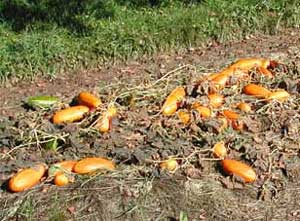 SAVING
SEED - If you grow open pollinated cucumbers and a good number of plants
(you want a reasonable gene pool, not just saving from one or two plants),
saving your own seed is as easy as just letting some of the cucumbers of each
plant mature. Cucumbers cross pollinate, so I grow only one variety if I'm
saving seed. If you store your seed well (cool, dry, dark) it will be viable for
many years so you don't have to save seed every year. If the plants and fruit
are having a good year - disease free, generous production of fruit, good
weather for maturing - I simply choose to leave a cucumber here and there to
mature, usually the ones that escaped my notice and have already grown beyond
the nice pickling stage. If it's a great year, I simply stop harvesting when I'm
tired of making pickles and let the rest of the crop mature.
SAVING
SEED - If you grow open pollinated cucumbers and a good number of plants
(you want a reasonable gene pool, not just saving from one or two plants),
saving your own seed is as easy as just letting some of the cucumbers of each
plant mature. Cucumbers cross pollinate, so I grow only one variety if I'm
saving seed. If you store your seed well (cool, dry, dark) it will be viable for
many years so you don't have to save seed every year. If the plants and fruit
are having a good year - disease free, generous production of fruit, good
weather for maturing - I simply choose to leave a cucumber here and there to
mature, usually the ones that escaped my notice and have already grown beyond
the nice pickling stage. If it's a great year, I simply stop harvesting when I'm
tired of making pickles and let the rest of the crop mature.
Maturing cucumbers will turn yellow then dark orange or yellow and their
skin/shell becomes less tender as they age, well past . Light frosts don't
bother them even if the leaves are damaged and I leave them in the garden until
hard freezes are predicted. I then bring them inside to set and further mature
their seeds for at least several weeks (which isn't hard since I'm plenty busy
doing other things this time of year). At some point before they get too soft
and mushy I cut them open and scoop the seeds out into a bowl. There's usually
enough juice to let them ferment (which takes care of that gelatinous covering
on the seed and might take care of some diseases, too). If not, add a little
water. Stir several times a day and let them ferment for several days. Then
clean the seed. I do this by adding water, letting the seeds settle to the
bottom, pouring off the debris. Keep doing this until the seed is clean, then
strain and dump on a towel to remove as much water as possible. Spread out on a
plate or cookie sheet and let air dry until they snap when bent. Old envelopes
work well for seed packets (note the year and where you originally got the seed,
as well as the proper name). Store in a cool, dry, dark place and you'll have
more then enough seed for you and your friends for many years.
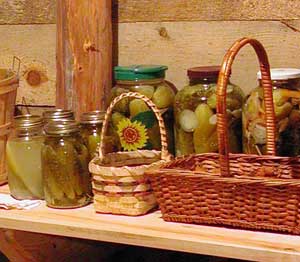 PICKLES
- There is hardly a need for me to give a pickle recipe. They are so prevalent
that one could spend all ones days trialing pickle recipes and never run out,
even should you live several lifetimes! Pickles have to be tops in the
preserving category for fun, variety, sharing and friendly community. Cucumbers
aren’t the only vegetable used for pickles, of course, but they are the top
contender. When I’ve been short on cucumbers I’ve successfully used small
zucchini and other squashes. Peppers and onions are often additions to the
pickle pot, or maybe some broccoli.
PICKLES
- There is hardly a need for me to give a pickle recipe. They are so prevalent
that one could spend all ones days trialing pickle recipes and never run out,
even should you live several lifetimes! Pickles have to be tops in the
preserving category for fun, variety, sharing and friendly community. Cucumbers
aren’t the only vegetable used for pickles, of course, but they are the top
contender. When I’ve been short on cucumbers I’ve successfully used small
zucchini and other squashes. Peppers and onions are often additions to the
pickle pot, or maybe some broccoli.
VINEGAR PICKLES - For all of that, I have to admit that I have, except
for an occasional foray elsewhere, for almost thirty years used but one recipe.
I cannot call myself a member of the elite pickler contingent with that. But we
do love the pickles I make! And if we run out it’s a major disappointment. In
spite of being mostly the same for all these years, they have and do change. The
recipe was originally from the “Joy of Cooking” many years ago and called “Sweet
Sour Spiced Pickles” made with vinegar, sugar, and spice (and cucumbers). I’ve
changed ingredients and proportions of sugar to vinegar, used maple syrup or
turbinado or sucanet instead white sugar, use cider vinegar instead of white,
and used different combinations of pickling and other spices; added onions,
peppers, broccoli, and made and eaten hundreds of jars of this, our favorite
pickle. My version is fairly strong and I use it mainly chopped up into our
daily luncheon “salad” (which is itself ever changing and hardly typical) and
into other dishes. This is the way I made one batch last year:
Slice fresh cucumbers into a brine of 1/3 cup pickling salt to 1 quart water,
let set overnight or all day (or overnight and all day)
Per pound of cucumbers (or about 3 cups) bring to a simmer/brief boil:
1 3/4 cups cider vinegar* and
3/4 cup sucanet or turbinado (or other brown sugar)
In each pint jar put 1 tsp mixed pickling spice (with cinnamon and cloves), some
dill, a few small grape leaves.
Drain brine off cucumbers, cover with hot water, drain. Pack not too tightly
into jars. Cover with hot vinegar/sugar solution leaving 1/2” headroom. Lid and
process as you normally do (boil-water-bath or steam-pressure-canner can) for 10
minutes. Or don’t process, if you don’t do that to your pickles. I used to, but
don’t anymore. I make sure the vinegar solution is boiling hot, fill to about
1/4” headroom, put heated lids on the jars with rings just as if I were going to
process them, then let them be. They seal and keep just fine, and it’s a lot
less work. If a jar doesn’t seal it is obvious and that jar gets put in the root
cellar and eaten early. All other precautions are the same as with any canning.
*My favorite is when we have a bumper apple crop, make more apple cider than we
can drink, and I make a large batch of good, strong apple cider vinegar to use
for the pickles. It’s a flavor you just can’t get with factory vinegar and I
cherish it when I have it.
FERMENTED PICKLES - In the past we didn’t eat many pickles plain out of
the jar, until last year I discovered “Fermented Brined Pickles”. Hardly new, of
course, it is probably the original pickle. Most people are familiar with
sauerkraut, but not so with other brined vegetables. But apparently the time was
right for me to re-discover brined pickles. I happened on an old book in the
library, read the section on fermented pickles and was intrigued. It sounded so
easy, and I’m all for less fuss-more fun; so I searched some more. I searched
through the large pickle section of the library and gleaned some information and
recipes, and I searched online and found more. It’s not as common as canned or
vinegar pickles, but there is a lot of good info out there (and passionate
proponents) and I soon had a pretty good understanding of the process. Which is
good when you are trying something new. What really interested me was the
possibility of fermenting in the jar, not in a crock.
Well, we had a good crop of pickles and I had collected a good number of
fermented pickle recipes. I was conservative and only tried six variations.
Really, they were all pretty much the same, but a little more salt here, little
less there, quart jar, gallon jar, small crock; no dill, some dill, lots of
dill; grape leaves vs cherry leaves; onions and peppers in one, just cucs in
others. It’s amazing how complicated you can make a very simple thing! But it
was fun. And we loved the pickles! I made 27 quarts of fermented pickles and we
ran out in February. And we are only two people (and two cats but they didn’t
share our pickle passion). Granted, I did give many jars away as gifts, pickles
seem made for that. But we had discovered a great new-old food. How wonderful
that it was also easy and good.
If you aren’t already a pickle fermenter, I’d suggest you research and read and
get familiar with the process (which is easy) and methods (not many). But be
prepared, home fermented pickles are not like always-the-same factory pickles.
They are alive and change flavor daily from the day they are made until the day
they are eaten, which is part of the fun, and delicious fun it is. Hopefully
this year I will have a great cucumber year and have enough pickles to see how
they taste past the 6 month mark (which is when we ate the last of last year’s
pickles).
All of the different recipes I tried were good, but this simple one is probably
my favorite:
Make a brine of 1 1/2 tablespoons pickling salt to 1 quart of water. Slice
cucumbers into a quart jar, include some dill and grape leaves. Cover to near
the top with brine. Put on the lid and let set (on a towel is a good idea) at
room temp for about 5 days or so, when the brine will be cloudy and definitely
fermenting (little bubbles rising). Wipe off jars and lids, top with more brine
if needed , and store in pantry or cool space which calms down the fermenting.
Start eating whenever you want, and keep eating until they are gone.
The great thing about the fermented pickle is you can easily make small batches
as the cucumbers come along. Or large batches even if you’re busy with other
things. They don’t take long. You can use whole cucumbers, quartered cucumbers,
sliced cucumbers, other vegetables. When a bunch of cucumbers were ready to be
picked but I was busy with other things, I quickly picked and washed them, put
them whole into a small crock and covered with brine. A small weighted plate (a
glass jar of water works well) keeps the cucumbers beneath the brine. Place a
cloth cover over the whole and let it set and ferment as with the jarred
pickles. Then later at my convenience I sliced them into jars.
You can ferment in the jar or in a crock. But if you ferment in a crock, you
have to skim the white scum off regularly which is why I prefer the jar method
-- it’s easier and less messy -- the scum doesn’t form. One change I will make
this year is to use plastic canning jar tops for these pickles. The brine did a
number on my regular metal rings and I’ve had to toss quite a few of them (salt
water and metal don’t mix). But since these pickles don’t need to be sealed, you
can use those neat looking old-fashioned metal bailed jars (Lehman’s Hardware
carries the rings if you need new ones), whether they are of old or new make.
As a bonus, the fermented brine is wonderful in itself -- used in biscuits or
breads, dressings or sauces, soups or sautes. It adds an extra something which
is hard to describe but is missed when it is gone. But by far the hardest thing
about these pickles is waiting long enough for some flavor to develop before
eating them all up. And keeping some for gifts and for later eating. It’s a
problem I can live with.
* * * * * *
Copyright
© Susan Robishaw
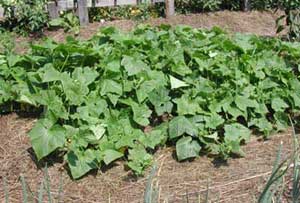



 But
not until the pickle shelf is full. If you've never had fresh
fermented pickles you might want to give them a try. We like them. I'd made
them off and on through the years, using directions from here and there,
coming up with my own recipe.
Usually they turned out good, though it's not a sure thing. But a few years
ago I bought a book that got me enthused once again about ferments -
"Fermented Vegetables" by Kirsten and Christopher Shockey. Now most of
their well written and wonderfully photographed book is a bit lost on me, being quite fond of simplicity in my
own kitchen/preserving life and not
much inclined to add to it. But I enjoyed reading the book
anyway and was really amazed at the array of ferments. They do a
great job of explaining the ins and outs and particulars of fermenting -
well worth it even if you don't want to ferment everything in sight. I
did try a few new things and came up with an adaptation of their onion
and sweet pepper relish that I really liked. I'll do that one again when
my peppers are ripe. It's a fun book.
But
not until the pickle shelf is full. If you've never had fresh
fermented pickles you might want to give them a try. We like them. I'd made
them off and on through the years, using directions from here and there,
coming up with my own recipe.
Usually they turned out good, though it's not a sure thing. But a few years
ago I bought a book that got me enthused once again about ferments -
"Fermented Vegetables" by Kirsten and Christopher Shockey. Now most of
their well written and wonderfully photographed book is a bit lost on me, being quite fond of simplicity in my
own kitchen/preserving life and not
much inclined to add to it. But I enjoyed reading the book
anyway and was really amazed at the array of ferments. They do a
great job of explaining the ins and outs and particulars of fermenting -
well worth it even if you don't want to ferment everything in sight. I
did try a few new things and came up with an adaptation of their onion
and sweet pepper relish that I really liked. I'll do that one again when
my peppers are ripe. It's a fun book. PLANTING
- Warmer climate gardeners plant their seed directly in the garden, grow and
harvest cucumbers as they mature and don’t worry much about a freeze prematurely
ending their harvest. But those of us with shorter seasons need to take a bit
more care if we want enough fruit for pickling. You can start your cucumbers
inside in small pots, transplanting them out later when the soil warms and
weather settles, and I have done that successfully. But my small greenhouse
space is at a premium in the spring and the less fussing I have to do with any
crop the happier I am. And a happier gardener makes for happier plants! So I use
cold frames.
PLANTING
- Warmer climate gardeners plant their seed directly in the garden, grow and
harvest cucumbers as they mature and don’t worry much about a freeze prematurely
ending their harvest. But those of us with shorter seasons need to take a bit
more care if we want enough fruit for pickling. You can start your cucumbers
inside in small pots, transplanting them out later when the soil warms and
weather settles, and I have done that successfully. But my small greenhouse
space is at a premium in the spring and the less fussing I have to do with any
crop the happier I am. And a happier gardener makes for happier plants! So I use
cold frames. SAVING
SEED - If you grow open pollinated cucumbers and a good number of plants
(you want a reasonable gene pool, not just saving from one or two plants),
saving your own seed is as easy as just letting some of the cucumbers of each
plant mature. Cucumbers cross pollinate, so I grow only one variety if I'm
saving seed. If you store your seed well (cool, dry, dark) it will be viable for
many years so you don't have to save seed every year. If the plants and fruit
are having a good year - disease free, generous production of fruit, good
weather for maturing - I simply choose to leave a cucumber here and there to
mature, usually the ones that escaped my notice and have already grown beyond
the nice pickling stage. If it's a great year, I simply stop harvesting when I'm
tired of making pickles and let the rest of the crop mature.
SAVING
SEED - If you grow open pollinated cucumbers and a good number of plants
(you want a reasonable gene pool, not just saving from one or two plants),
saving your own seed is as easy as just letting some of the cucumbers of each
plant mature. Cucumbers cross pollinate, so I grow only one variety if I'm
saving seed. If you store your seed well (cool, dry, dark) it will be viable for
many years so you don't have to save seed every year. If the plants and fruit
are having a good year - disease free, generous production of fruit, good
weather for maturing - I simply choose to leave a cucumber here and there to
mature, usually the ones that escaped my notice and have already grown beyond
the nice pickling stage. If it's a great year, I simply stop harvesting when I'm
tired of making pickles and let the rest of the crop mature. PICKLES
- There is hardly a need for me to give a pickle recipe. They are so prevalent
that one could spend all ones days trialing pickle recipes and never run out,
even should you live several lifetimes! Pickles have to be tops in the
preserving category for fun, variety, sharing and friendly community. Cucumbers
aren’t the only vegetable used for pickles, of course, but they are the top
contender. When I’ve been short on cucumbers I’ve successfully used small
zucchini and other squashes. Peppers and onions are often additions to the
pickle pot, or maybe some broccoli.
PICKLES
- There is hardly a need for me to give a pickle recipe. They are so prevalent
that one could spend all ones days trialing pickle recipes and never run out,
even should you live several lifetimes! Pickles have to be tops in the
preserving category for fun, variety, sharing and friendly community. Cucumbers
aren’t the only vegetable used for pickles, of course, but they are the top
contender. When I’ve been short on cucumbers I’ve successfully used small
zucchini and other squashes. Peppers and onions are often additions to the
pickle pot, or maybe some broccoli.